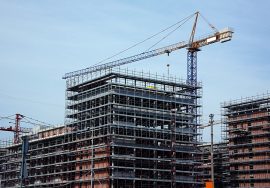
Carbon Emission Monitoring in Construction: Toward Sustainable Development
Carbon Emission Monitoring in Construction: A Step Toward Sustainable Development
As the global construction sector expands rapidly, the need to track and manage environmental impacts has become critical. Carbon emission monitoring is a key approach that allows builders, developers, and policymakers to measure, analyze, and reduce the greenhouse gases produced throughout a project’s lifecycle.
By implementing carbon emission , the industry can take meaningful steps toward sustainable construction, energy efficiency, and achieving net-zero carbon goals.
What Is Carbon Emission Monitoring?
Carbon emission monitoring refers to the process of identifying, measuring, and tracking the amount of carbon dioxide (CO₂) and other greenhouse gases emitted during construction activities.
This includes emissions from:
-
Manufacturing and transportation of building materials
-
Energy consumption on-site
-
Waste generation and disposal
-
Operational energy use after construction
Accurate carbon emission monitoring enables project teams to set reduction targets and evaluate the effectiveness of sustainable strategies.
Why Carbon Emission Monitoring Is Important
Construction contributes nearly 40% of global carbon emissions, making it one of the most significant sources of climate change. Implementing carbon emission systems helps reduce this environmental burden by:
-
Identifying major sources of emissions
-
Supporting better decision-making for material and energy use
-
Ensuring compliance with green building standards
-
Helping achieve LEED-certified construction and carbon-neutral building goals
By adopting a proactive approach to carbon emission monitoring, companies can improve efficiency, cut costs, and meet sustainability commitments.
How Carbon Emission Monitoring Works in Construction
1. Data Collection
The first step in carbon emission is gathering data on material usage, energy consumption, and transportation. Tools like sensors, smart meters, and Building Information Modeling (BIM) systems help automate data tracking.
2. Calculation and Analysis
Collected data is analyzed using carbon accounting software or life cycle assessment (LCA) tools to calculate total emissions. This identifies areas where emissions can be minimized.
3. Reporting and Benchmarking
Results from carbon emission are documented and compared with industry benchmarks or sustainability targets such as IGBC or GRIHA standards.
4. Reduction and Optimization
Based on the findings, project teams can implement energy-efficient construction methods, switch to low-carbon materials, or integrate renewable energy sources to reduce emissions.
Benefits of Carbon Emission Monitoring
-
Reduced Environmental Impact: Enables better control of emissions at all construction stages.
-
Regulatory Compliance: Meets national and global sustainability standards.
-
Improved Efficiency: Identifies inefficiencies in energy or material use.
-
Data-Driven Decisions: Supports smart planning and long-term sustainability goals.
-
Enhanced Reputation: Showcases commitment to climate responsibility and green practices.
Carbon Emission Monitoring in India
India’s growing focus on carbon emission reflects its commitment to the Paris Agreement and sustainable infrastructure development.
Organizations like the Indian Green Building Council (IGBC) and Bureau of Energy Efficiency (BEE) encourage builders to measure and report their carbon emissions. Government programs such as the Perform, Achieve, and Trade (PAT) scheme and Energy Conservation Building Code (ECBC) also promote carbon emission and reduction in the construction industry.
Adopting advanced technologies such as IoT sensors, digital twins, and carbon tracking software can further enhance monitoring accuracy and transparency.
Steps to Implement Carbon Emission Monitoring in Construction
-
Conduct a Baseline Assessment: Evaluate the current carbon footprint of the project.
-
Set Emission Targets: Establish achievable, measurable carbon reduction goals.
-
Integrate Monitoring Tools: Use digital systems for real-time data collection.
-
Report and Review: Regularly document results to ensure continuous improvement.
-
Engage Sustainability Experts: Collaborate with professionals experienced in carbon emission monitoring and reporting.

Partner with AMS India for Sustainable Carbon Management
At AMS India, we specialize in carbon emission and sustainable construction practices. Our experts provide data-driven insights, carbon audits, and actionable strategies to minimize your project’s environmental footprint.
From low-carbon construction to renewable energy integration, AMS India helps you build responsibly while aligning with global climate goals.
Conclusion: Monitoring Today for a Cleaner Tomorrow
Carbon emission is not just a regulatory requirement—it’s a pathway to sustainability. By measuring and managing emissions at every stage of construction, we can reduce environmental impact and contribute to a carbon-neutral future.
Through continuous carbon emission , the construction industry can build smarter, cleaner, and more resilient cities for generations to come
Read more related articles to enhance your knowledge and make informed decisions
Cost-Effective Modular Construction: Fast, and Sustainable Building Solutions
Smart Modular Buildings: Innovative, Efficient, and Sustainable Construction








